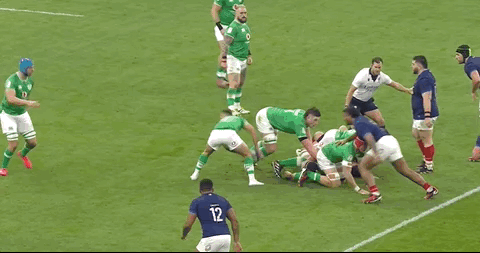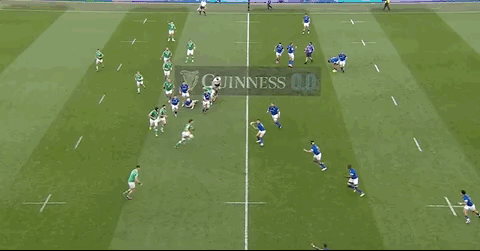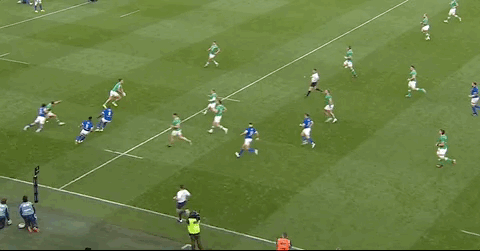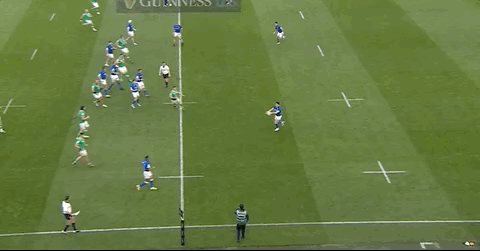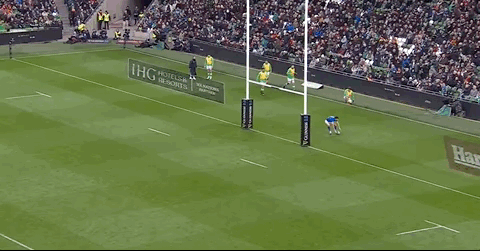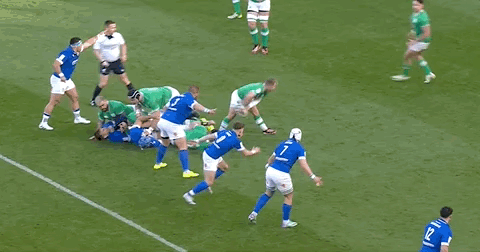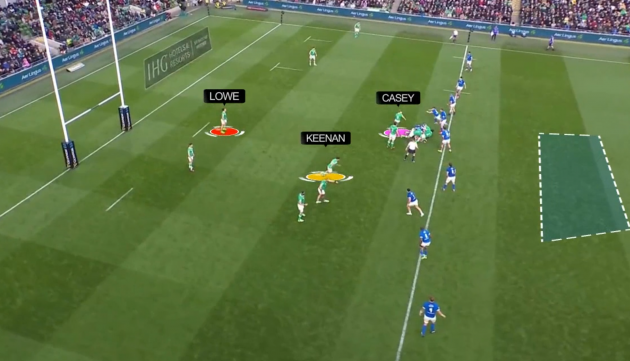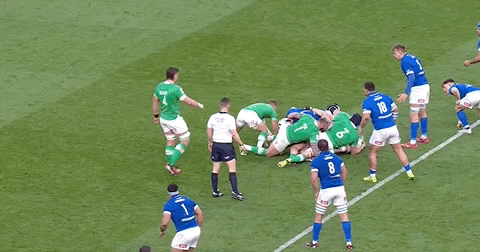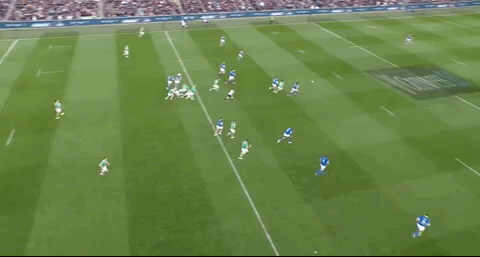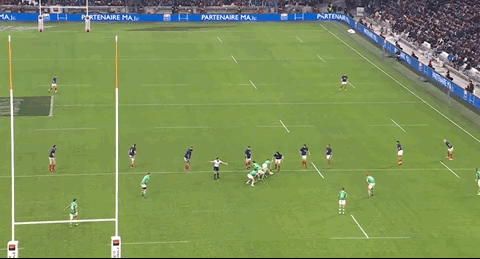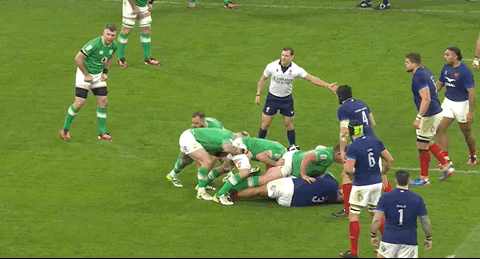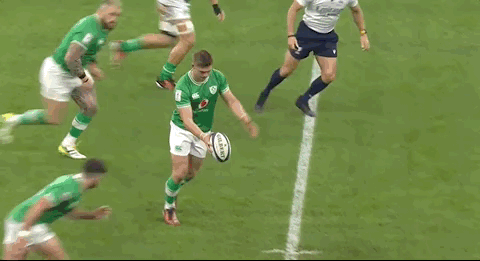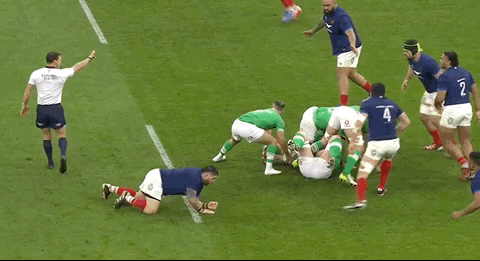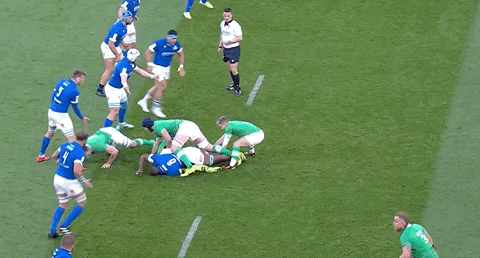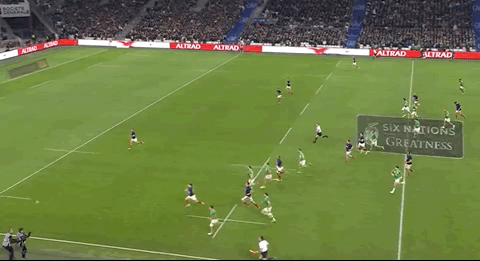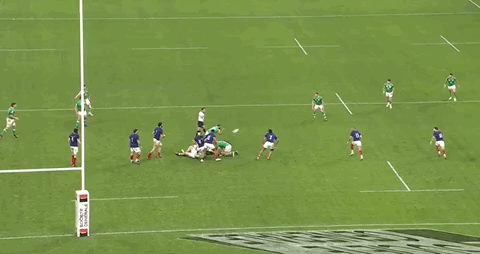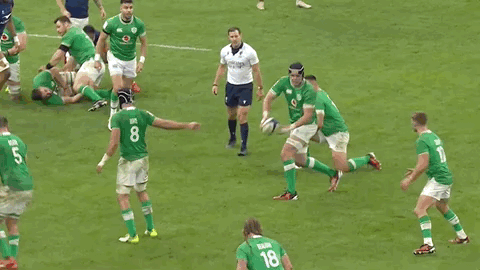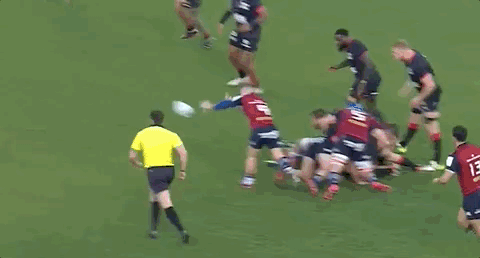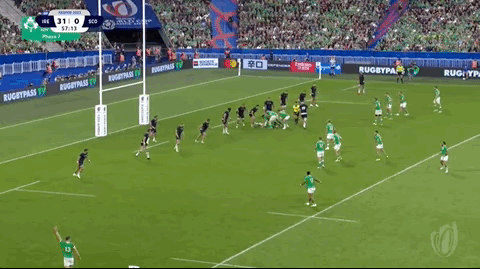YOU’LL PROBABLY ONLY need one guess at who has delivered the longest kick from hand in this Six Nations so far.
The sight of James Lowe hammering the ball downfield for Ireland has become so routine that the power of his kicking game is almost under-appreciated. It will likely feature prominently once again this afternoon against Wales.
Among his 12 kicks in play for Ireland against France was this effort in the first half, the longest recorded kick in this year’s championship.
Massive kicks like this from Lowe can almost seem run-of-the-mill at this stage. They’re anything but. We now have exact data for these efforts thanks to the Gilbert x Sportable smart ball.
You might have noticed the numbers flashing up on TV just under the scoreboard during games. The data is presented by Sage, who are the official insights partner to the Guinness Men’s Six Nations, and in this instance it let us know that Lowe’s kick had flown a whopping 56.5 metres before being fielded by Damian Penaud.
It’s a great example of why Ireland have been so good at ‘exiting’ in this Six Nations. By that, we essentially mean getting the ball out of their defensive third of the pitch, where turnovers of possession can obviously be very costly.
Watching Ireland’s two games so far, you’ve probably been struck by how the opposition have created relatively few chances. Again, the numbers strongly back up that impression.
Remarkably, Ireland limited Italy to just two attacking entries into the Irish 22 in the second-round clash in Dublin, having limited France to only six. In stark contrast, Ireland have enjoyed 12 entries into the French 22 and then 13 entries into the Italian 22.
Ireland’s excellent defence has been crucial in limiting opposition entries, particularly their aggressive work at the lineout, but their kicking game is also key. Ireland are good at making sure the game isn’t played in their territory and Lowe’s long left-footed kicking is key to that.
Ireland are a passing team, with Sage’s numbers showing they have the highest pass-to-kick ratio in the Six Nations at almost 8:1, as well as stringing together the most sequences of 10+ passes per possession. But when Ireland do kick, they usually do it well.
Ireland dominated France in the kicking stakes, gaining a total of 734 metres of territory compared to France’s 470 metres.
Lowe’s left boot is pivotal to Ireland’s efforts. Below, he lands the ball 52.8 metres upfield before it rolls on into Italy’s 22.
Only Scotland halfbacks Ben White and Finn Russell have notched more kick metres than Lowe in the opening two rounds of the Six Nations, while just three players have kicked in play more often than Lowe’s 20.
In their opening two games, Ireland have come out on top of many of the exchanges of kicks that happen so regularly in rugby, providing them with chances to attack.
Take this instance against Italy. The Italians are attacking in Ireland’s half when centre Ignacio Brex dinks a kick behind to create pressure, possibly forcing an error from Ireland near their own 22.
Ireland react well, with Hugo Keenan typically unflustered in turning, seemingly signalling to Lowe to stand off the ball, gathering with three Italians on his tail, and passing calmly to Lowe.
Now Lowe’s kicking power comes into the equation as he smashes the ball down into Italy’s half, where Paolo Garbisi fields it.
Lowe’s long kick means Garbisi has had to retreat and with only one team-mate behind him, he decides to launch another kick aimed at putting Ireland under pressure.
Garbisi fires up a garryowen that drops just outside Ireland’s 22, meaning they can’t mark it, but Keenan does brilliantly again.
His ability to catch and pass under pressure from the Italian chaser means Lowe now has a chance to really punish Italy, given that their backfield is exposed, especially with two of their players receiving medical attention.
The Ireland wing produces another astonishing kick deep into Italy’s half, finding grass and then chasing hard himself as the ball rolls all the way into the Italian in-goal area.
Remember that the law now means that if Garbisi grounds this ball in his in-goal area, it will be a goal line drop out to Italy.
With his entire team all well upfield and after an energy-sapping passage of play, Garbisi can’t attempt to run the ball out so he instead clears to touch for an Ireland lineout nearly 15 metres inside the Italian half.
It’s a big win for Ireland in this exchange, going from defending in their own half after a turnover to having a prime attacking platform in the Italian half in the space of 40 seconds.
Lowe is key to Ireland’s ability to exit well but one of the possible issues is that everyone knows it, so he has come under increased pressure from potential blockers. Ireland appear to be wary of becoming too predictable and we have seen some variation.
In the instance below seconds into the Italy game, Lowe is set up for a left-footed kick but instead passes to his right where out-half Jack Crowley uses his right foot to clear.
Crowley has plenty of time to wind up for his kick, while we can also see below that Ireland have held two players out on the right touchline in a clear indication that they’ve planned this exit.
This ends up being a fairly unsuccessful exit for Ireland as the Italians are able to get beyond the Irish 10-metre line before being tackled.
Most teams see it as the minimum expectation for their exit kicks to leave them defending beyond their own 10-metre line either after the kick has found touch or after the first tackle has been made beyond that mark.
Still, it’s positive for Ireland to be painting different pictures for the opposition and there was a highly successful exit kick variation in the second half.
Again, we can see Lowe set up for his usual left-footed exit below.
But scrum-half Craig Casey dinks a short chip over the ruck instead of passing back to Lowe, with Keenan the chaser.
This is clever from Ireland because they know the Italians will be covering very deep in the backfield, wary of the length of Lowe’s kicks.
Without a sweeper in the Italian set-up here, there’s clear space. It takes an excellent kick from Casey to exploit it, with Keenan the designated chaser. Ireland’s fullback gathers on the bounce and races all the way up to just outside Italy’s 22.
This passage ends up with an Irish try but Robbie Henshaw’s effort is disallowed for double movement. Still, that’s a hugely successful exit and a play that Ireland had also tried against France.
Ireland tend to use Jamison Gibson-Park’s right foot when exiting from closer to the right touchline, given that it’s far more difficult for Lowe to kick on that side. The effort below from Gibson-Park against France is a good one, finding touch near the halfway line.
Ireland also use their scrum-half to hang up constable exits slightly further upfield when they’re in possession between their own 22 and 10-metre line.
Gibson-Park provides an example against France below.
This box kick has a hang time of 4.3 seconds and travels 23.1 metres upfield, according to the Sage data, which are good numbers for making a box kick contestable. Anything over four seconds of hang time is ideal.
As we can see, Lowe is well escorted by the retreating French players before getting into the air but Ireland can instantly tackle Thomas Ramos as he lands. Two phases later, Lowe makes an intercept as France force a ball-in-hand attack. France then get caught offside for an Irish penalty.
So less than a minute after Gibson-Park’s box kick, which comes soon after the very first Lowe kick we looked at in this piece, Ireland are kicking down into the French 22 and earn the opening three points of the game once they’re in there. Another big win.
Speaking of hang time, out-half Crowley has delivered some excellent restarts for Ireland, particularly in the French game. This is the opening kick-off of the Six Nations and he nails it, hanging the ball high in the air to allow Keenan to make a good tackle.
While Ireland like to kick the ball out of their own half, their excellent ball-in-hand attack usually comes to the fore once they’re in possession beyond their own 10-metre line and certainly once they’re inside the opposition half.
Sage’s data again backs up the impression of Ireland as a team who like to pass the ball. They have made more passes than anyone else in the Six Nations so far with 408 but it’s revealing that they have the joint-shortest average distance per pass at 6.0 metres.
Under Andy Farrell, Ireland favour short, snappy passes within tight attacking shapes, forcing the defence to constantly adjust and make decisions. They tend to avoid long passes that hang in the air for too long.
All of that said, kicking remains part of their armoury aside from just exiting.
Interestingly, two similar kicks from Crowley in the middle part of the pitch have been blocked down in their games so far. Early on against France, Crowley had this effort blocked by Grégory Alldritt.
Then against Italy, Crowley had this effort blocked down by Manuel Zuliani.
While he is kicking to his right in the first example and his left in the second, both kicks are against the grain of Ireland’s attack.
Crowley is looking to pick out backfield space vacated by defenders who have moved to cover space in the other direction.
While we don’t have perfect wide angles for the kicks, it seems both were clever in conception but fell down on execution with Crowley a little too close to the defence and kicking on a low trajectory as he aims to find grass quickly. It will be interesting to see if Crowley attempts any similar kicks in this championship.
Farrell’s team haven’t had a 50:22 kick yet but this effort from Jack Conan late on against the French was as good as one.
Tadhg Beirne has just won a breakdown turnover, meaning France aren’t defensively organised, and while he could pass, Conan instead picks out the backfield space before delivering a deft left-footed grubber kick.
Keenan chases at pace and the covering Matthieu Jalibert has little choice but to nudge the ball into touch.
Again, the kick leaves Ireland with a prime attacking platform in opposition territory.
While Ireland haven’t really needed to use their attacking kicking as a weapon so far in this Six Nations, given that they’ve freely scored tries by running and passing, it would make them an even more potent force if they get that aspect of their game firing.
Crowley attempted this grubber in the first half against France.
There is space in behind France here but in a more central area than where Crowley’s kick goes, while the French bodies in front of him mean it was always going to be hard to win the race to the ball. There’s also no penalty advantage playing here for Ireland so it means a 22-metre drop-out for les Bleus.
Later in the game, Crowley had this cross-field kick in the French 22.
Ireland do have penalty advantage this time so there’s nothing to lose, but we can see that no Irish player is waiting out wide to contest Crowley’s kick.
In reviewing these instances, it seems likely that Farrell and co. will have encouraged Crowley to continue to look for opportunities with his attacking kicking but to refine his decision-making and execution.
They know he has the skills, as for the Munster try below as he chips for Simon Zebo to score.
Below, Crowley’s brilliant cross-field kick sets up a try for Garry Ringrose in their World Cup win against Scotland last year.
Ireland will be excited to get more of this from Crowley as he continues to grow into their number 10 shirt.
It’s something to keep a close eye on today against Wales.

